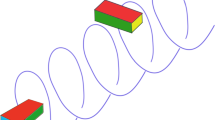Abstract
Consider a swiveling arm on an oriented complete riemannian surface composed of three geodesic intervals, attached one to another in a chain. Each interval of the arm rotates with constant angular velocity around its extremity contributing to a common motion of the arm. Does the extremity of such a chain have an asymptotic velocity? This question for the motion in the euclidian plane, formulated by J.-L. Lagrange, was solved by P. Hartman, E. R. Van Kampen, A. Wintner. We generalize their result to motions on any complete orientable surface of non-zero (and even non-constant) curvature. In particular, we give the answer to Lagrange’s question for the movement of a swiveling arm on the hyperbolic plane. The question we study here can be seen as a dream about celestial mechanics on any riemannian surface: how many turns around the Sun a satellite of a planet in the geliocentric epicycle model would make in 1 billion years?
















Similar content being viewed by others
Notes
puisque nous sommes en train de faire des hypothèses, une hypothèse de plus ne nous coûtera pas davantage.
L’astronomie est utile, parce qu’elle nous élève au-dessus de nous-mêmes ; elle est utile, parce qu’elle est grande; elle est utile parce qu’elle est belle; voilà ce qu’il faut dire.
“It is hard and maybe even impossible to say something on the nature of angle \(\varphi \) in the general case” (English translation). Lagrange’s angle \(\varphi \) is the continuous branch of the argument \(\varphi (t)\) defined above.
The same assumptions about \(\omega _j\) hold for the Theorem 3 and the swiveling arm on the hyperbolic plane.
References
Bohl, P.: Über ein in der theorie der säkularen Störungen vorkommendes problem. J. Reine Angew. Math. 135, 189–283 (1909)
Ghys, É.: Resonances and Small Divisors. Kolmogorov’s Heritage in Mathematics, pp. 187–213. Springer, Berlin (2007)
Hartman, P., Van Kampen, E.R., Wintner, A.: Mean motions and distribution functions. Am. J. Math. 59(2), 261–269 (1937)
Hausmann, J.-C.: Sur la Topologie des Bras Articulés, Algebraic Topology Poznań, Lecture Notes in Mathematics, pp. 146–159 (1989)
Hausmann, J.-C.: Contrôle des bras articulés et transformations de Möbius. L’Enseignement Math. 51, 87–115 (2005)
Jessen, B.: Some aspects of the theory of almost periodic functions. In: Proceedings of International Congress of Mathematicians, Amsterdam, 1, ICM, pp. 304–351 (1954)
Jessen, B., Tornehave, H.: Mean motions and zeros of almost periodic functions. Acta Math. 77, 137–279 (1945)
Kapovich, M., Milson, J.: On the moduli space of polygons in the Euclidean plane. J. Differ. Geom. 42(1), 133–164 (1995)
Kornfeld, I.P., Sinai, Ya G., Fomin, S.V.: Ergodic Theory. Springer, Berlin (1982)
Lagrange, J.-L.: Théorie des Variations séculaires des éléments des Planètes, I, II, Nouveaux Mémoires de l’Académie de Berlin, 5 (1781, 1782)
Poincaré, H.: La Valeur de la Science, Flammarion, Paris (1911)
Sakai, T.: Riemannian Geometry. American Mathematical Society, New York (1996)
Weyl, H.: Mean motion. Am. J. Math. 60, 889–896 (1938)
Zvonkine, D.: Configuration spaces of hinge constructions. Russ. J. Math. Phys. 5, 2 (1997)
Acknowledgements
I am grateful to Anatoly Stepin for sharing with me the question about the asymptotic angular velocity of a swiveling arm on the hyperbolic plane when I was a student at Moscow State University. I thank Étienne Ghys for very fruitful discussions that helped me change the approach of this question and drastically simplify the arguments. I also thank Bruno Sevennec as well as the anonymous referee for pertinent questions and remarks that helped me improve the text. The principal part of this work was accomplished when I was a graduate student at the UMPA laboratory at École Normale Supérieure de Lyon. I thank my reporters, François Beguin and Alain Chenciner, for their comments. During the period of the work on this project, I was supported by the LABEX MILYON (ANR-10-LABX-0070) of Université de Lyon, within the program “Investissements d’Avenir” (ANR-11-IDEX-0007) operated by the French National Research Agency (ANR) as well as by a personal grant l’Oréal-UNESCO for Women in Science 2016.
Author information
Authors and Affiliations
Corresponding author
Additional information
Publisher's Note
Springer Nature remains neutral with regard to jurisdictional claims in published maps and institutional affiliations.
In memory of my grandfather V. V. Beletskii, a mathematician and a poet.
Rights and permissions
About this article
Cite this article
Paris-Romaskevich, O. Epicycles in the Hyperbolic Sky. Arnold Math J. 4, 251–277 (2018). https://doi.org/10.1007/s40598-019-00107-w
Received:
Revised:
Accepted:
Published:
Issue Date:
DOI: https://doi.org/10.1007/s40598-019-00107-w



